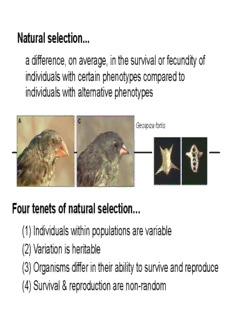
Natural selection - Amherst College PDF
Preview Natural selection - Amherst College
Natural selection... a difference, on average, in the survival or fecundity of individuals with certain phenotypes compared to individuals with alternative phenotypes Geospiza fortis Four tenets of natural selection… (1)! Individuals within populations are variable (2)! Variation is heritable (3)! Organisms differ in their ability to survive and reproduce (4)! Survival & reproduction are non-random Mytilus edulis, Blue mussel! 1988 1817! Respond to presence of predators by thickening shells – defense response is inducible –! P = 0.001 P = 0.573 P = 0.011 P = 0.145! Hemigrapsus sanguineus Carcinus maenas Asian shore crab! European green crab! Anolis sagre i Anolis sagrei typically terrestrial (longer legs ~ faster escape from predators) Invasion by Leiocephalus carinatus causes Anolis sagrei to be arboreal …predicted that leg length would Leiocephalus carinatus DECREASE in arboreal populations of Anolis sagrei lizards following invasion by Leiocephalus carinatus! Anolis sagre i CONTROL! All Anolis sagrei individuals tagged / measured Leiocephalus carinatus were introduced on 6 islands INTRODUCED! Censused after 6 (and 12) months to record survival Six INTRODUCTION islands ! Longer legs! Six CONTROL islands ! CONTROL! Shorter legs! Components of natural selection Probability of survival before and Gamete recognition systems during the reproductive period Segregation distortion Mating success Average number viable offspring Natural selection is an average difference in the survival or fecundity of individuals with certain phenotypes Demonstrating adaptation What is a trait for? Do individuals that possess the trait contribute more offspring to future generations? How does a trait develop? Who has it? Adaptation Any heritable trait (structure, physiological ability, behavior) that makes an organism better able to survive & reproduce The evolutionary process leading to the persistence of such a trait in populations Natural selection is the differential contribution of offspring to the next generation by certain genotypes Demonstrating adaptation What is a trait for? Do individuals that possess the trait contribute more offspring to future generations? How does a trait develop? Who has it? Adaptation Any heritable trait (structure, physiological ability, behavior) that makes an organism better able to survive & reproduce The evolutionary process leading to the persistence of such a trait in populations (Upper) Collecting localities, substrate color, and mouse color. Sample sizes at each site are given. Pie charts are the proportion of light and dark mice at each site. Rectangles indicate substrate color. (Lower) Light and dark C. intermedius from the Pinacate locality on light and dark rocks. Coat color variation well studied in mammals Association studies using markers in candidate pigmentation genes (Agouti & Mc1r) Genotype-phenotype association between Mcr1 alleles & coat color in animals from Pinacate.
Description: